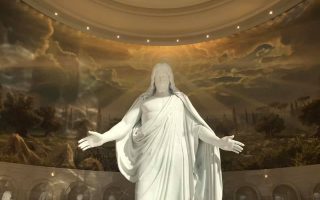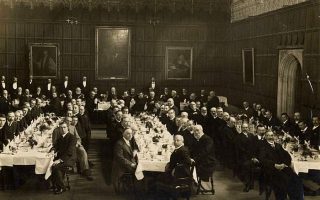This post was written by Kathryn Charles, the current Humanities Center Intern.
Under most circumstances, I would jump at the chance to visit Monet’s garden at his home in Giverny, France. Under jet-lagged circumstances in the early morning, I did not. My husband, Sam, who had visited the garden before, promised me that if it wasn’t the most beautiful place I’d ever seen, I could go back to the car and sleep. I shuffled into the garden reluctantly, and the green-shuttered house, bursting gardens, and mirror-like water lily pond was, in fact, one of the most beautiful places I’d ever seen.
As an impressionist, Claude Monet’s primary objective was to capture the world as he experienced it in the moment, rather than mimicking the life-like mythological, religious, or historical paintings that had been dominant subjects of art for centuries. And as often happens when the world is viewed in a new way, viewers had mixed opinions. Conservative critics snubbed his impressionistic work as unfinished and unrealistic, calling for art that was more “truthful” to life. Yet Monet’s rejection of artistic tradition wasn’t rebellion for its own sake; it was his pursuit of truth in its purest artistic form. He sought to convey a deeper, experiential truth by focusing on the impressions tied to the interplay of light, color, and atmosphere in a single moment.
In the last thirty years of his life, Monet focused on a series of approximately 250 oil paintings collectively titled Water Lilies. He installed easels throughout his flower garden in Giverny to capture the water lily pond from different angles under varying light and weather conditions. Though the subject remained the same, each painting was distinct in mood, color, and atmosphere. Accordingly, each painting in the series reveals a uniquely true moment in the garden, illustrating the mood or the light as it really existed. Monet evidently believed that truth was never so simple that it could be studied once and understood.

While I’ve found that truth is difficult to define with any degree of satisfaction, I would like to share some truths that I believe I’ve found about truth. I believe that there is a capital-T Truth, yet I also believe that Truth is likely larger than any one perspective can fully comprehend. Consequently, what I believe to be true need not negate the truths others hold. Seemingly opposing truths could coexist, complementing each other if viewed from the right angle. So, if I want to understand truth, I will need to be open to more than what I can perceive in a single moment, and I will also likely need to discard my expectations for what that truth will look like.
In 1880, Monet wrote, “Above all, I wanted to be truthful and exact. For me a landscape hardly exists at all as a landscape, because its appearance is constantly changing … You have to know how to seize just the right moment in a landscape instantaneously, because that particular moment will never come again, and you’re always wondering if the impression you got was truthful.” Obviously, we can gather from this quote that the search for truth was important to Monet. We can also gather that the truest truth that Monet found about the garden was its changeability. Like a garden whose landscape shifts as it grows and decays, truth is vivid and alive. But truth can only be organic because we, who perceive truth, are organic, with constantly changing perceptions of reality. While Truth may exist independently from our understanding, we can not separate our understanding of Truth from our personal perception.
Oftentimes, we dig in our heels to defend our worldview because we believe that there is space for only one right and one wrong. Then, out of insecurity and ignorance, we stop listening to anything or anyone that does not align with our own idea of what truth is, and create an echo chamber that affirms our belief in our own rightness. This simply will not do if we want to understand and receive more truth. Monet could only begin to understand the truth of the garden by studying it from hundreds of perspectives. We must embrace a multiplicity of experiences and allow truth to reveal itself.
For example, with our human understanding, we might assume that we’ve got a hold on spiritual understanding because we’ve studied one aspect of God in one lighting. This understanding is brittle and prone to break because we will inevitably encounter different seasons and periods of growth in the garden. God embodies all perspectives and truths, even those that seem contradictory. God is both loud and quiet, the lion and the lamb, present in both joy and grief. While the core remains the same, God’s behavior changes to what is needed. It follows that in order to be perfected and become like God, who encompasses all truth, we must learn to embrace multiple perspectives, even those that initially appear dissonant.
I think it’s important that we also apply this thinking to ourselves. Like many people, I have a tendency to define myself as either wholly good or wholly bad at certain skills or traits. This can create a dangerously rigid perspective of myself that also often falls into a binary of either wholly good or wholly bad as a human being. If I feel that I have succeeded at something, I assume that I am good; this belief is easily toppled as soon as I fail in the slightest degree. But I’m learning that several things can be true at the same time. I am sometimes mean and sometimes generous. I am sometimes motivated and sometimes tired. I am sometimes ignorant and sometimes wise. These truths don’t cancel each other out; they reflect the complexity of being a living, changing human existing through personal changes in season, lighting, and atmosphere. By embracing this complexity, it becomes much simpler to be patient and kind with myself and others, who are also made up of a complexity of truths. It becomes simpler to listen to what others believe without trying to enforce my own idea of truth above all else. And it becomes simpler to let my mind change about what is true as my personal landscapes grow and decay.
I’m grateful that Sam didn’t push me to reject my own truth that morning in the parking lot of Giverny—I was ridiculously tired. I’m also grateful that I considered another truth: that Monet’s beautiful, shifting garden might still be more compelling to me than sleep. Both truths coexisted. And had I limited myself to only my own perspective, I would have missed out on something extraordinary.







